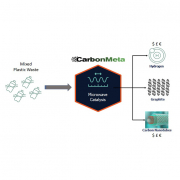How to Be a RecyclingHero this Holiday Season
Five top tips for an environmentally friendly winter season.
The Global Recycling Foundation (the organisation behind Global Recycling Day, which takes place annually on 18th March) is calling on people across the globe to put the planet first this festive season and be a #RecyclingHero when it comes to gift wrapping, decorations and more.
It is estimated that both the UK[1] and Australia[2] create 30% more waste than usual over the festive season. Similarly, in the US, total plastic packaging consumption adds up to be over 125,000 tons[3] during the winter holidays and in South Africa, household waste increases by up to 25%[4]. This year, the Global Recycling Foundation is calling on people to turn over a new leaf to reduce their waste and start some new, environmentally friendly, holiday traditions.
The theme for Global Recycling Day 2020 is #RecyclingHeroes – recognising the people, places and activities that showcase what an important role recycling plays in creating an environmentally stable planet. We can all be #RecyclingHeroes this festive season, and the Global Recycling Foundation has created five suggestions we can all implement in our own homes and with friends and family.
- Send eco-friendly cards
Look for ways to send religious holiday and festive cards with zero environmental impact. Research has shown that one billion Christmas cards are sold in the UK[5] and over two billion are sent in the US[6] each year. This year why not switch to e-cards or eco-friendly cards instead? Plantable cards are also growing in popularity, where recipients are gifted with plant seed embedded cards that can be sowed in the spring.
Cards should also be recycled or composted after they have been used, if the material allows for it. For cards that cannot be recycled, they can instead be repurposed or even made into decorations for future celebrations.
- Rethink home decorations
Everyone loves to decorate their homes during the holiday season, but we should all be looking at ways to do this with as little impact as possible. Many decorations are used year after year, which already makes them sustainable. However, those looking to buy new decorations should search for designs made from brass, glass or natural materials such as wood and other plant life – avoiding ones made from plastic.
In the US there are plenty of schemes to ‘adopt a Christmas tree’ which is an alternative to purchasing plastic ones each year. In the UK, some Christmas trees can be rented from farms. These trees can be used and decorated over the festive period and then can be given back to farms to be replanted in January. For those who do purchase their own trees, they can be recycled into chippings for parks and woodland areas after the holidays rather than thrown away. In Australia for example, most local governments will continue to collect Christmas trees for recycling throughout January[7], and the service can be easily booked online.
For other religious celebrations such as the Hindu festival of Diwali, those celebrating can craft their own decorations rather than purchasing new ones. Decorative door hangings popular at Diwali time, known as toran, can be handmade from left over craft papers, fresh flowers and mango leaves. For other festivals such as Chinese New Year, rather than purchasing new decorations, homemade ones can be just as good and if the right materials are used, can be easily recycled. For example Chinese paper lanterns, banners and signs can be made using recyclable paper.
- Consciously cut back on plastic waste
In 2018, China used 9.4 million tonnes of packaging material[8], with India also generating around 5.6 million tonnes of plastic waste[9] each year – there is clear potential to tackle waste reduction on a global scale. Each individual can consciously make an effort during the holiday season to reduce the amount of plastic used and purchased. For example, avoiding purchasing Christmas crackers, New Year’s Eve party poppers and plastic gifts will all help in reducing the carbon footprint.
- Rethink gifting
Gift givers should rethink present buying during the holidays and all year round, including birthdays. Experiential gifts are becoming more and more popular, with gifts of days out and unique experiences preferred over packaged presents. For example, instead of buying someone the latest perfume as a gift, look for refillable perfume bottles or treat them to a spa and wellness experience, a cookery class or membership with an art gallery. Those that do want to purchase physical gifts can look for sustainable and eco-friendly ones such as edible presents like chocolates and biscuits, potentially helping to reduce the number of unwanted gifts as well.
- Choosing the right wrapping paper
Many of us don’t realise that most wrapping paper rolls contain elements that can’t be recycled such as glitter, foil and plastic. Shoppers can look for recyclable and sustainable options such as cloth, brown paper or tissue, which can easily be recycled. In Australia alone, 8,000 tonnes of wrapping paper is used every Christmas[10], which is the equivalent of 50,000 trees.
Ahead of the third Global Recycling Day, the Global Recycling Foundation will continue to promote ways that we can all champion recycling in our everyday lives. Global Recycling Day was created to celebrate the crucial part that recycling plays in preserving the earth’s primary resources (water, air, coal, oil, natural gas and minerals). Aiming to bring people together and advocate ways to put our planet first, Global Recycling Day highlights the need to consider recyclable materials as resources rather than waste, demonstrating the power of the “Seventh Resource” – the goods we recycle every day.
Find out more at: www.globalrecyclingday.com
Source: BIR / Global Recycling Foundation, Photo: Couleur / Pixabay (05.12.2019)
[1] HouseBeautiful.com: https://www.housebeautiful.com/uk/lifestyle/a1158/recycle-christmas-waste/ [2] National Storage: https://www.nationalstorage.com.au/blog/christmas-waste-australia/ [3] GWP: https://www.gwp.co.uk/guides/christmas-packaging-facts/ [4] Times Live: https://www.timeslive.co.za/sunday-times/lifestyle/2018-12-16-the-colour-for-christmas-is-green-as-sa-chooses-zero-waste-gift-wrapping/ [5] Greeting Card Association: http://www.greetingcardassociation.org.uk/resources/for-publishers/the-market/facts-and-figures [6] TPI Solutions: https://cdn2.hubspot.net/hub/37010/file-13884805-pdf/docs/christmas_card_infographic.pdf [7] SBS: https://www.sbs.com.au/language/english/how-to-recycle-your-christmas-tree [8] Reuters: https://www.reuters.com/article/us-singles-day-pollution/on-singles-day-green-groups-warn-of-chinas-surge-in-packaging-waste-idUSKBN1XL0A4 [9] PHYS: https://phys.org/news/2019-10-plastic-recycling-india.html [10] The Clean Collective: https://thecleancollective.com/blogs/eco-and-healthy-living-blog/6-facts-about-christmas-waste-amp-what-you-can-do-to-help-show-the-planet-some-kindness-this-christmas







